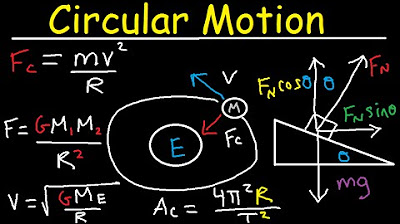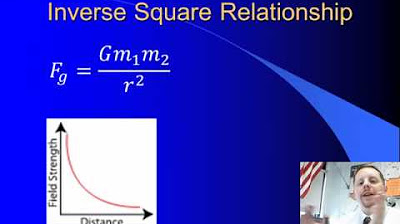Everything Revolves Around You: Crash Course Kids #22.1
TLDRIn this engaging episode, Sabrina discusses the fascinating concept of orbits, focusing on the Earth's natural satellite, the Moon, and human-made satellites like the International Space Station (ISS). She explains how the balance between an object's velocity and Earth's gravitational pull allows for stable orbits, preventing objects from crashing into the Earth or escaping into space. The Moon's formation, the ISS's role, and the importance of maintaining the right speed for satellites to avoid falling to Earth or escaping Earth's gravity are highlighted in this informative and entertaining summary.
Takeaways
- 🌙 The Moon orbits the Earth, taking about 27 days to complete one full orbit.
- 🚀 Artificial satellites, like the International Space Station (ISS), also orbit the Earth, serving various purposes such as scientific research and communication.
- 🌌 Gravity is a natural force that pulls objects towards each other, keeping them in orbit around larger bodies like Earth.
- 🔄 Orbits are the paths that objects follow around other objects in space, such as the Earth's orbit around the Sun or the Moon's orbit around the Earth.
- 💥 The Moon is thought to have formed from debris ejected from Earth after a massive impact with a planet-sized object.
- 🏙️ The ISS is a collaborative project among multiple countries, including the United States, Russia, Japan, and Canada, and serves as a habitat and laboratory in space.
- 🏃♂️ The ISS orbits Earth at a high speed, completing 16 orbits per day.
- 🌐 There are thousands of satellites around Earth, each with specific functions like weather forecasting, monitoring droughts, and providing signals for phones and TVs.
- 🌍 Satellites and the Moon don't crash into Earth because their velocity and the Earth's gravitational pull are in a delicate balance that keeps them in orbit.
- 💫 Satellites are essentially in a continuous state of freefall towards Earth, but their forward velocity prevents them from actually hitting the planet.
- 📈 Maintaining the correct velocity is crucial for satellites to stay in orbit and avoid being pulled down by Earth's gravity.
Q & A
Why does Mr. Moon appear green in the script?
-Mr. Moon appears green because he is feeling a little jealous due to the discussion focusing more on the Sun and less on him.
What is the main topic of the episode?
-The main topic of the episode is orbits, specifically focusing on objects that orbit the Earth, including the Moon and artificial satellites.
What is an orbit?
-An orbit is the path that an object follows around another object, such as how the Earth travels around the Sun or how the Moon orbits the Earth.
What is gravity and how does it relate to orbits?
-Gravity is a force or the natural pull of objects towards each other. It is responsible for keeping objects like the Moon in orbit around the Earth without crashing into it.
How did the Moon form according to the script?
-The Moon is believed to have formed billions of years ago when a planet-sized object hit the Earth, causing chunks of it to be blasted into space, which then came together to form the Moon.
How long does it take for the Moon to fully orbit the Earth?
-It takes the Moon about 27 days to fully orbit the Earth.
What is the International Space Station (ISS)?
-The International Space Station (ISS) is a large artificial satellite where astronauts live and perform scientific experiments in near-weightless conditions. It is a collaborative project involving many countries.
How many orbits does the ISS complete around the Earth each day?
-The ISS completes 16 orbits around the Earth every day.
What keeps satellites from crashing into the Earth despite its gravity?
-The balance between the velocity of the satellites and the Earth's gravitational pull keeps them in a stable orbit, preventing them from crashing into the Earth.
What happens if the Moon's speed was much faster or slower than its current velocity?
-If the Moon's speed was much faster, it would escape Earth's gravity and fly off into space. If it was much slower, Earth's gravity would pull it down to Earth.
How do satellites maintain their orbit around the Earth?
-Satellites maintain their orbit by moving at a velocity that is neither too slow nor too fast, which keeps them from being pulled down by Earth's gravity or escaping into space.
Outlines
🌙 Introduction to the Moon and Orbits
The video begins with Sabrina and Mr. Moon discussing the Moon's jealousy over the attention the Sun receives. The focus shifts to orbits, explaining that many objects in space, including artificial satellites and the Moon, orbit the Earth. The concept of an orbit as a path followed by an object around another is introduced, with the Earth's orbit around the Sun as an example. The role of gravity in maintaining these orbits is highlighted, and the question is raised about why objects in orbit don't crash into the Earth due to gravity.
🌌 Understanding Earth's Orbiting Bodies
This section delves into the specifics of Earth's natural and artificial satellites. The Moon, Earth's only natural satellite, is described, including its formation and surface features. The time it takes for the Moon to orbit the Earth is mentioned. Artificial satellites, such as the International Space Station (ISS), are introduced, emphasizing their purpose and the collaborative effort of multiple countries in creating it. The ISS's role as a space laboratory and its fast orbit around Earth are highlighted, along with the variety of functions other satellites serve, from weather forecasting to communication.
🚀 The Science Behind Orbital Motion
The explanation continues with the factors that determine the orbit of a satellite, both natural and artificial. The balance between Earth's gravitational pull and the object's velocity is crucial for maintaining a stable orbit. The concept is illustrated by considering what would happen if the Moon's speed were too fast or too slow. The idea that satellites, including the Moon, are in a continuous state of falling towards Earth but never actually hitting it due to their velocity is introduced. The importance of maintaining the right velocity to avoid being pulled into Earth's gravity is emphasized.
Mindmap
Keywords
💡Orbit
💡Gravity
💡Artificial Satellites
💡Moon
💡International Space Station (ISS)
💡Velocity
💡Craters
💡Lava
💡Planet-sized Object
💡Drought
💡Communication Satellites
Highlights
The Moon's appearance is discussed as being green due to jealousy over the attention the Sun receives.
Orbits are the focus of the episode, specifically those around the Earth, including artificial satellites and the Moon.
An orbit is defined as the path an object follows around another object, like the Earth around the Sun or the Moon around the Earth.
Gravity is introduced as a natural force that pulls objects towards each other and is responsible for keeping objects on Earth's surface.
The question of why objects in orbit don't crash into Earth due to gravity is posed.
The Moon is Earth's only natural satellite and has a surface covered by craters and plains, likely formed by asteroid impacts and lava flows.
The Moon is believed to have formed billions of years ago from Earth chunks blasted into space after a massive impact.
It takes the Moon approximately 27 days to complete one orbit around the Earth.
Artificial satellites, such as the International Space Station (ISS), are human-made objects orbiting Earth and serve various purposes including scientific research.
The ISS is a collaborative project among multiple countries and is the largest object ever flown in space.
Artificial satellites perform diverse functions including weather forecasting, monitoring drought, and facilitating communication signals.
The balance between an object's velocity and Earth's gravitational pull is crucial for maintaining a stable orbit.
If the Moon's speed were too fast, it would escape Earth's gravity; if too slow, it would crash into Earth.
Artificial satellites closer to Earth also rely on this balance of speed and gravity to remain in orbit.
Satellites and the Moon are in a continuous state of falling towards Earth but do not crash due to their tangential velocity.
Maintaining the correct velocity is key for satellites to avoid being pulled into Earth's gravitational pull.
Transcripts
Browse More Related Video

13.4a Orbital Mechanics | A2 Gravitational Fields | Cambridge A Level Physics

High School Physics - Orbits

Greenhouse Effect | #aumsum #kids #science #education #children

Gravity Compilation: Crash Course Kids

Centripetal Acceleration & Force - Circular Motion, Banked Curves, Static Friction, Physics Problems

High School Physics - Newton's Law of Universal Gravitation
5.0 / 5 (0 votes)
Thanks for rating: